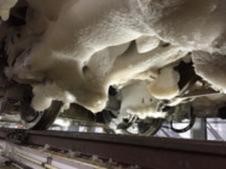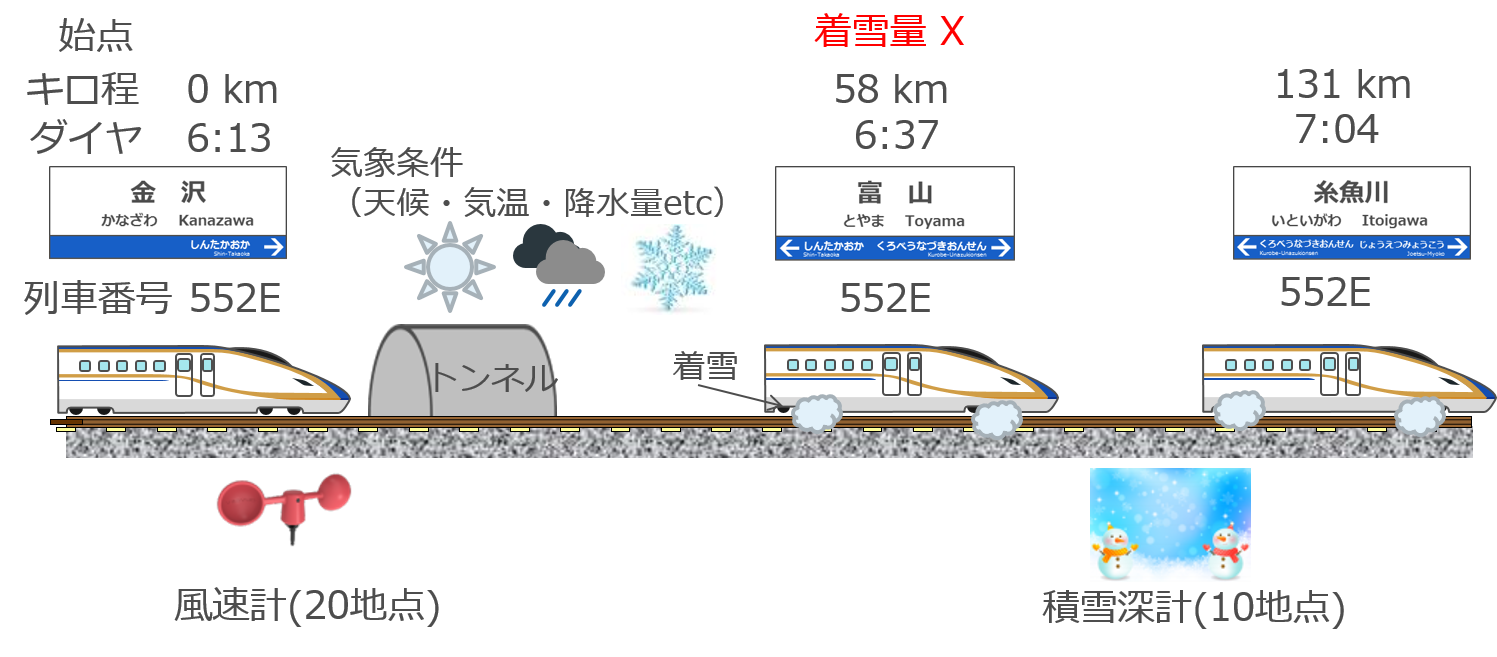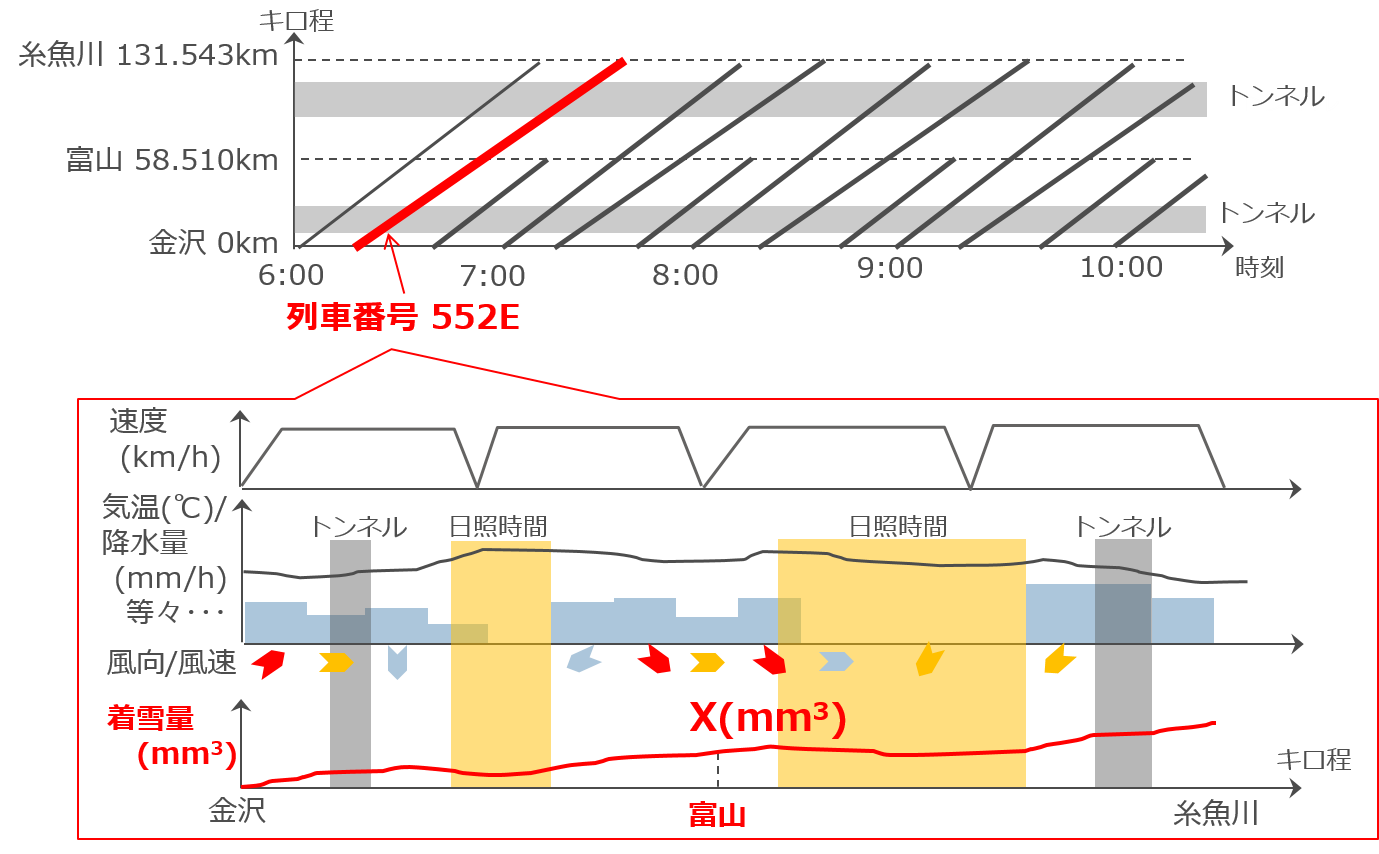When high speed rail rolling stock, Shinkansen, travels during snowfall, snow adheres on its bogie part. An increase in the amount of adhering snow may cause its falling into the track. This falling has a risk of destruction of track infrastructure and so on. Therefore, prediction of the largest amount of adhering snow on the bogie with the risk of falling on the day is required in order to make a decision on the necessity of the next day's removing adhering snow on the previous day. For this reason, improving the prediction accuracy of the amount of adhering snow is expected super effective to support deciding on the necessity of removing snow on the next day.
In the competition, participants will create a model that predicts the amount of adhering snow quantitatively by analyzing historical data of weather conditions, traveling conditions and amount of adhering snow. Though it may be a very complicated problem as it requires viewpoints of both meteorology and railway operation, we would like to make use of your great ideas, technical skills, and creativity to find an innovative solution and keep on improving the quality of railway operations.

Data
The following data is given for creating algorithms (see Download Data page for more details).
Adhering snow data
Amount of snow accumulated on the railway bogie part measured by laser scanner when the railway stops at Toyama station and Itoigawa station.
Geographic data
These data include kilometrage and longitude / latitude information of civil engineering structures (railway station / tunnel) and JR-owned measuring instruments (anemometer / snow depth meter).
Train traveling data
Diagram: Indicates common timetable corresponding to each train (local and express) ID.
Train without adhering snow at the arrival of Kanazawa station: It indicates the ID number of train whose amount of adhering snow is zero at Kanazawa station as it leaves from Rolling stock maintenance depot to Kanazawa station. As for the other train ID numbers, the amount of adhering snow is unknown as they turn back at Kanazawa station.
Meteorological Agency data
Of the historical meteorological data acquired from Meteorological Agency, we have extracted data with following condition.
Peroid: Dec 1, 2015 ~ Mar 31, 2016 and Dec 1, 2016 ~ Mar 31, 2017
Locations: Kanazawa・Toyama・Itoigawa
※Other than the above condition, participants can use open data as long as they are free.
Anemometer data
Data measured in seconds by anemometers uniquely set up (at 20 points in total) by JR West.
Wind speed (Instantaneous): Measured in units of 0.1m/s.
Wind direction (Instantaneous): A direction given by degrees. North corresponds to 0°, and the angles increase clockwise.
Snow depth data
Depth of snow measured on track surface and on trench located at the outside of the railway track. Depending on the set up and measurement point of snow depth gauge, the data to be utilized may vary. For more details, please refer to [doc_1.pptx].
Track: Measured with the height of rail surface as the reference (0cm)
Trench: Measured with the bottom of gutter as the reference (0cm)
Glossary of technical terms
Adhering snow: Amount of adhering snow on the rolling stock bogie.
Kilometrage: Accumulated distance from Kanazawa station, which indicates a location of station, tunnel, and each measuring instrument.
Train ID: An identifier given to each train in a diagram.

Basic information
Operating section: Kanazawa station -> Itoigawa station
Target variable: Amount of snow accretion on the railway bogie part at the arrival of Toyama station for all railways during test set period
Train set period: Jan 19 to Dec 31, 2016
Test set period: Jan 1 to Mar 31, 2017



 Participation information is being registered. Please wait for a while.
Participation information is being registered. Please wait for a while.